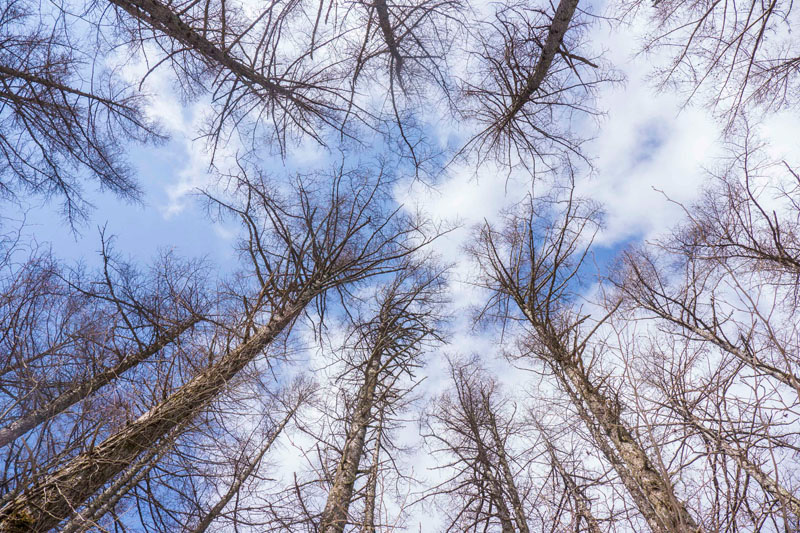Interviewer: This is my first time here at the Forest Therapy Research Institute. It's a very warm and inviting place.
Asano: At this research institute, we conduct research for developing new ways for people to live comfortably while using forests. 66% of the land in Japan is forest, most of which is in the mountains. Our approach is that Japan's forests are an important social infrastructure and cultural asset. Today, almost nobody regards Japan's forests as an energy source and timber source, or pays attention to their cultural relevance. I think it's important to adopt a perspective that fully integrates forests into our social systems.
Interviewer: Could you give us a basic outline of your research?
Asano: I specialize in the field of forest hydrology and erosion control. Broadly speaking, hydrology is the study of the movement of water on Earth. In my case, I study hydrology in mountains and forests, specifically examining where rainfall in mountains accumulates, and the route and mechanism by which the water leaves. For example, small mountain streams continue to flow with water even if it doesn't rain for one or two months, making us wonder how it works.
On rainless days, we collect samples of water flowing in streams periodically, to study changes in the stable isotope ratio of the water. When we compare this with rainwater, it is apparent that the released water is from rainfall that occurred more than a year ago.
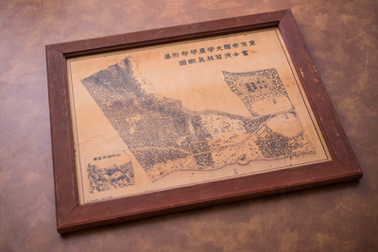
This rare map from 1935 shows the forests and facilities of the University Forest at Yamanakako as they were at the time. Many of the facilities no longer exist. Photo: Jun'ichi Kaizuka.
Interviewer: The released water is that old? That's surprising.
Asano: It means that there is a system in mountains that stores water and gradually releases it. One year is actually on the short side. The springs in the nearby Oshino Hakkai area release water that is about 80 years old. Some springs in the University of Tokyo Hokkaido Forest release water that is about 30 years old. That is how long water can stay in mountains, so once the water in mountains becomes contaminated, the negative effects can emerge decades later or even a century later. At the same time, when it rains, there is a system that releases large amounts of water over a short period of time. I'm sure that you've heard of people going camping in the mountains, who get caught in a downpour and end up stranded on the shoals of a river. Why do these things happen? Because when it rains upstream of a river, the water level can rise 30 centimeters or more in just a minute, rising so quickly that people become stranded on the shoals before they can escape. When it rains, the amount of water increases in mountain streams, causing water levels to rise but also increasing the speed of flow, so that all of a sudden a lot of water flows through the streams. Therefore, we not only study water flow on normal rainless days, but also major changes that occur over these kinds of short periods and the mechanisms that are at work. This is very important for disaster management.
Interviewer: Are the changes also affected by the volume of rain that falls in a short period of time?
Asano: Yes. That is why the risk of flooding increases when there are more concentrated downpours. It's important for flooding prediction to obtain data on river flows during heavy rains that occur within a short period, but it is difficult to obtain this data. Flooding only occurs when there are heavy rains that happen every few decades or few hundred years, so we don't know if we can obtain data for such heavy rains in the limited area that we observe in our lifetime. For example, the Ecohydrology Research Institute started conducting water measurement observations in the 1930s. They obtained runoff data when over 400 millimeters of total rainfall occurred during Typhoon No. 15 in 2011, obtaining valuable data that is rare even from an international perspective. We don't have sufficient data to predict major floods that may occur once in 100 or 200 years. Additionally, we have to obtain long-term data in order to understand how changes in water circulation are affected by changes in forests that occur over decades and centuries. We have to keep obtaining long-term data while keeping track of changes in water flows over short periods from rain. Time is crucial to the study of mountain water, both long-term and short-term time.
Forest science developed out of forestry science, which spread to Japan from Germany, while river research spread to Japan from the Netherlands. However, river research from the Netherlands and its flat geography could not be directly applied to Japanese rivers and our steep landscapes. In a natural environment, different locations produce different phenomena, so the content of the research also changes. Significant advances are being made in erosion control science and forest hydrology science for mountainous regions, in places such as Japan, Taiwan, the Western United States, and the European Alps. All these regions are characterized by steep landscapes.
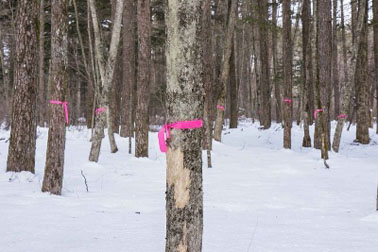
The forest is used to explore the possibilities for the healing effects of forests, including through forest management. The trees marked with pink-colored tape will be thinned once the snow melts. Photo: Jun'ichi Kaizuka.
Interviewer: I recently heard of a case in forest science, where data for an observation experiment that was started by a Meiji-era researcher was finally confirmed recently, with a different researcher writing a research paper on it three generations later. It seems like a field that is enormous in scale.
Asano: There are many cases like the one you just mentioned that symbolize the nature of our field. That's why people tend to view forest science as a long-term field of study. That's not always the case. There is research that is based on short-term data in addition to the research based on long-term data. Forest science covers a broad span of time, from short-term to long-term study. However, this cannot be said about genome research, one of the fastest-developing fields of study today. It takes so much time to carry out genome research for trees. Trees take about 20 years to mature and if you are to conduct research that needs data to be collected across several generations, that takes a long, long time to do.

Visitors can scan QR codes with their mobile phones to get information about the forest. The low-cost system is easy to install, maintain and update, while not disrupting the scenery. Photo: Jun'ichi Kaizuka.
Interviewer: To change the subject somewhat, do you perceive time differently in the forest compared with in the laboratory?
Asano: It's completely different! It's so busy and rushed in the laboratory and office! That's why I try to find the time to go and do fieldwork in the forests, where I can relax.
Interviewer: The passage of time in the forest is completely different from how it passes in town.
Asano: That's right. A century ago in Japan, there were mountain faces in many places over the country that had been denudated. However, previous generations worked many months and years to stop sediment runoff and plant trees, so the denudated mountains have today been transformed into lush mountains. If forests could think, they must be wondering what humans are up to, seeing us panic over the problems that arise from clearcutting and deer population growth. Forests just keep growing over a hundred years, regardless of human circumstance or need. There is a big difference in how we perceive time, and the passage of time for a forest. Given how denudated areas have been transformed into lush mountains, it is important not to give up and keep working hard, even with regard to matters for which we cannot predict the outcome because of our human perception of time. We keep getting older and society continues to change, so we tend to panic about these things, but the forests are still there. As a forest scientist, I feel very fortunate to be able to continue conducting research while immersed in the passage of time in forests.
This interview took place on February 14, 2013 at the Forest Therapy Research Institute.
About the Forest Therapy Research Institute
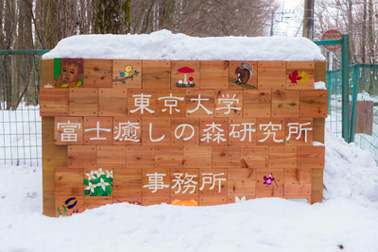
Forest Therapy Research Institute
Established: 1925
Location: Yamanakako, Minamitsuru District, Yamanashi Prefecture (south central part of Lake Yamanaka)
Elevation: 990-1,060 meters
Area: 38 hectares (including land leased from Yamanashi Prefecture)
Forest description: The area is largely man-made forest of mainly larch with some red pine planted in the 1920s, replenished with native broadleaf trees.
Facilities: Yamanaka Dormitory-Naito Seminar House, situated in the University forest.
Photo: Jun'ichi Kaizuka.
The Forest Therapy Research Institute, previously the University Forest at Yamanakako, was initially established through a local donation of land. Old drawings show that the area resembled more of a grassy plain at the time, without the tall native larch trees and red pine trees that stand there now. From early on, the forest was used for the cultural refinement of University of Tokyo students, who initially helped to prepare the land. The Kozai Plain (named after Yoshinao Kozai, the 10th President of the University of Tokyo) was planted and maintained by students of the University working alongside staff and is now a healthy forest. Located in the center of the Lake Yamana resort area, the site was long used for educational research centering on recreational forest use and landscape maintenance. In 1999 it was renamed the Forest Therapy Research Institute and operates a project focused on the healing aspects of forests through sustainable community use of and engagement with forests, while conducting research into the healing effect of forests gained through the act of managing them.
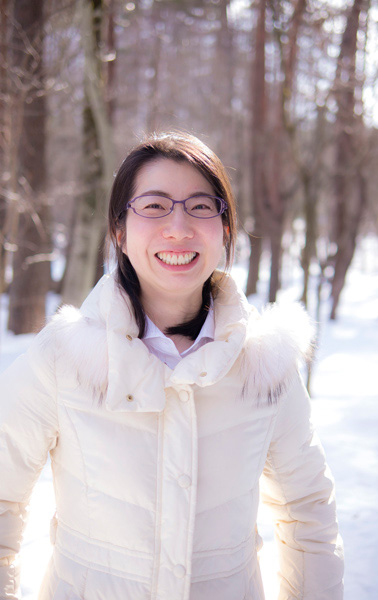
Lecturer Yuko Asano
Graduated from the Faculty of Agriculture, Kyoto University in 1996. Completed PhD studies at the Graduate School of Agriculture, Kyoto University in 2001, earning a PhD in agriculture. Appointed as research fellow of the Japan Society for the Promotion of Science in 2001. Appointed as assistant professor for the university forest of the Graduate School of Agricultural and Life Sciences, the University of Tokyo in 2003, later appointed a lecturer in 2008. Appointed as director of Forest Therapy Research Institute in 2012, working from the University of Tokyo Chichibu Forest.



